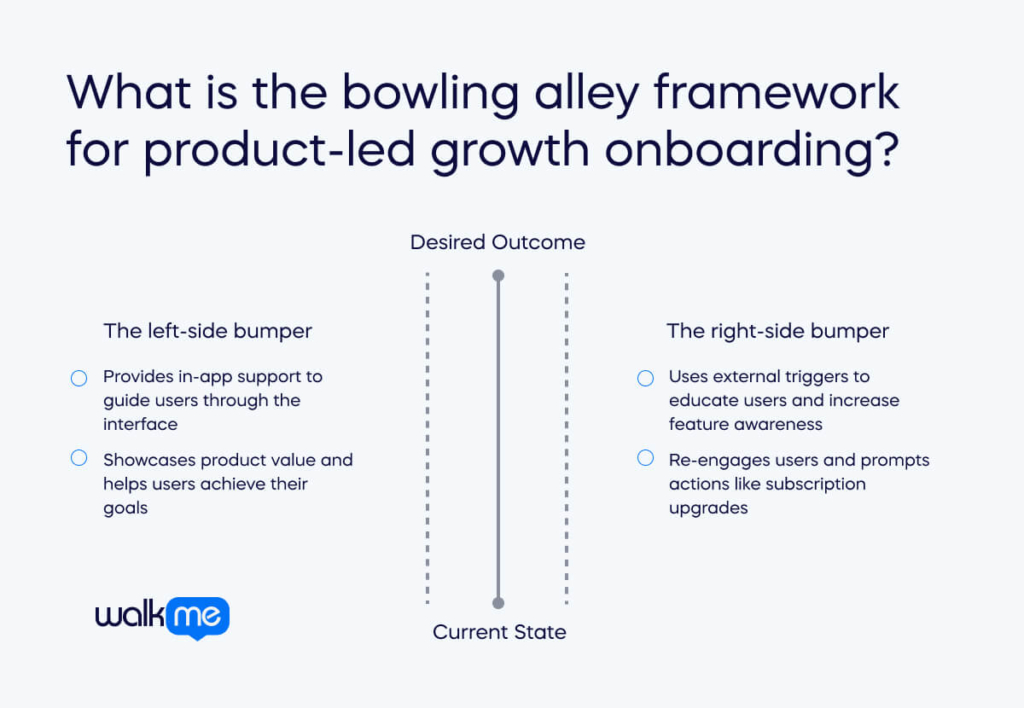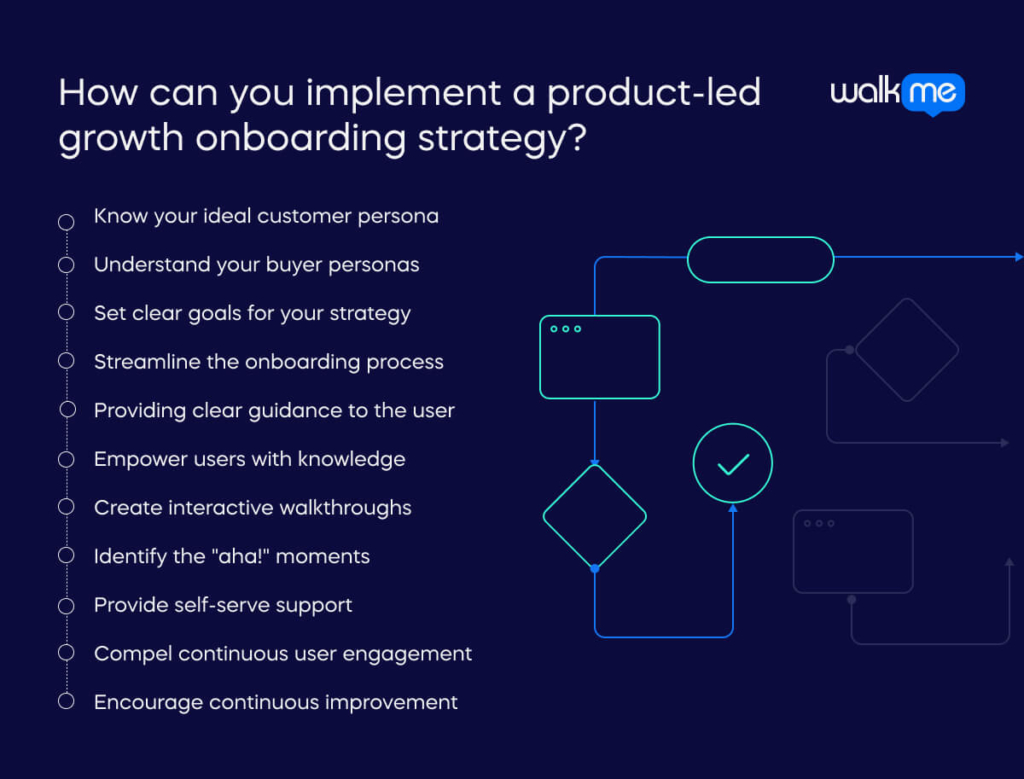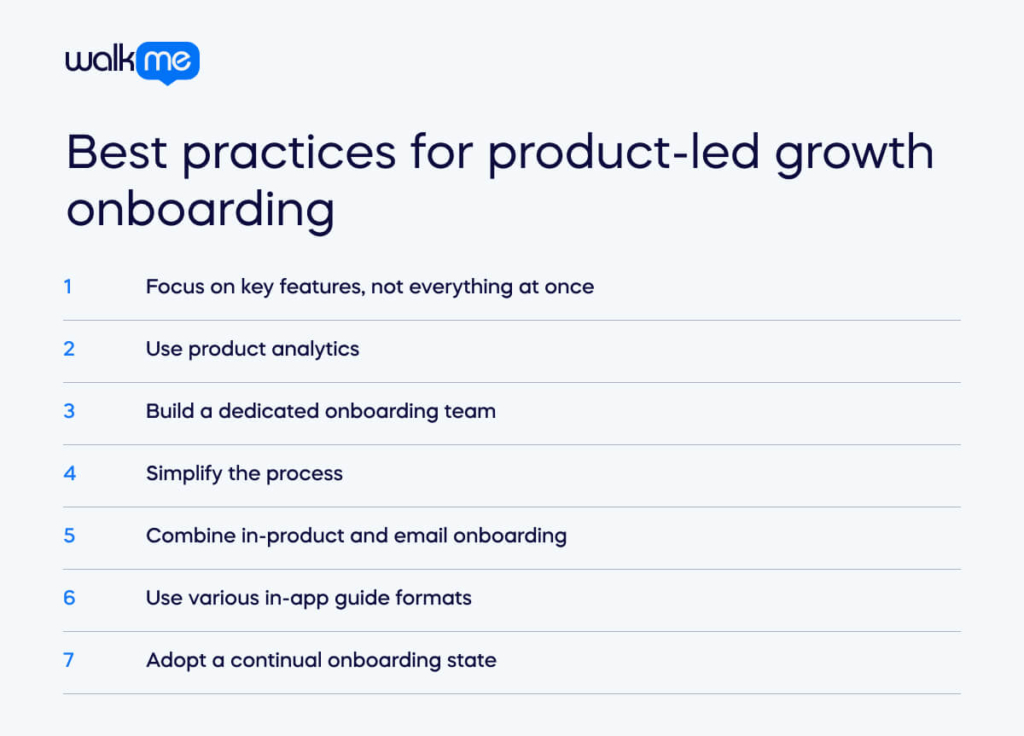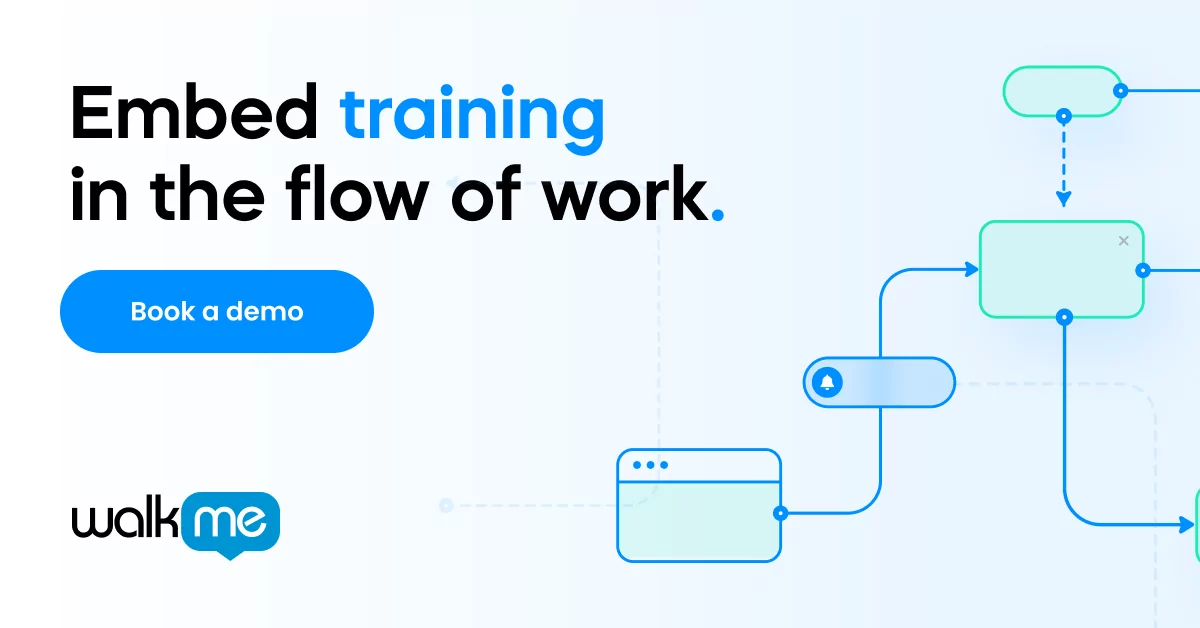Employee onboarding helps new users learn about your product and understand its value. Each company has its unique onboarding approach. They aim to make users comfortable enough to use the product regularly.
First impressions during onboarding are crucial—they shape long-term satisfaction and business success.
Traditionally, onboarding involved many teams and methods, such as emails, PDFs, or webinars. These methods are labor-intensive and don’t scale well.
Product-led growth onboarding uses the product itself to teach users. It provides employee training and guidance directly within the product. It also speeds up how quickly users find value. Most of all, it reduces the need for human-led sessions that can delay learning.
In this article, you will learn what product-led growth onboarding is. You will also learn about the best tips for implementation. We will also give you examples of companies who have done it well and go through its main types.
What is product-led growth onboarding?
Product-led growth onboarding encourages users to explore a digital product’s full range of features. Instead of relying on meetings or emails, users learn about the product’s interface and value through guided tours within the application.
In the past, companies relied on meetings and emails for onboarding. This became costly and less scalable as the business grew. Product-led growth shifts focus to self-service, which refers to trial or freemium scenarios where human interactions are reserved for high-value prospects.
This approach simplifies the customer experience. It allows customers to discover the product’s features and benefits on their own. Companies can build loyalty and streamline the customer journey by empowering users to navigate independently. This enhances engagement and satisfaction.
Why is product-led growth onboarding important?
Product-led growth onboarding is crucial because users form quick opinions about products that are hard to change later. The initial experience impacts their perception of your brand. Implementing a product-led growth strategy ensures users have an exceptional onboarding experience from the start.
One major benefit is better customer retention. By providing a smooth onboarding process, you build trust and loyalty early on, increasing customer lifetime value and retention rates.
Product-led growth onboarding also enhances your product’s value proposition. It allows for unique value creation to increase income through various revenue channels. It does this by focusing on retention to boost revenue and ensure long-term growth.
Additionally, it reduces customer acquisition costs (CAC) by engaging users effectively from the beginning. This strategy converts regular users into loyal customers. It leads to efficient business growth by prioritizing customer experience.
What is the bowling alley framework for product-led growth onboarding?

The bowling alley framework, developed by Wes Bush, states that product-led growth onboarding is like bowling. The first strike refers to the user’s “aha!” moment. As a result, you achieve the desired outcome with your product.
The framework includes bumpers on each side of the lane:
- The right-side bumper uses external triggers to educate users and increase awareness of features. It also re-engages them in the app and prompt actions like subscription upgrades. This bumper focuses on conversations.
- The bumper on the left provides in-app support. It guides users through the interface to showcase your product’s value, helping them achieve their goals.
What is the difference between product-led growth onboarding and product-led growth?
Product-led onboarding and product-led growth use the product to help users. But they serve different stages of the customer journey.
Product-led onboarding focuses on the initial user experience. It aims to guide users quickly to their “aha!” moment with tutorials, tours, and tooltips.
Product-led growth spans the entire customer lifecycle. It uses strategies like in-app experiences and upsell prompts from acquisition to retention and expansion.
Product-led onboarding is part of product-led growth. It enhances scalability and focuses on user-centric strategies, marketing, sales, and operational efficiency.
What are the main types of product-led growth onboarding?

Here are the main types of product-led growth onboarding that companies can adopt:
Peer-led onboarding
Peer-led onboarding leverages customer communities as a support channel for new users. It provides a 24/7 accessible resource hub. Customers share their expertise. This boosts confidence in the product through their satisfaction and passion.
In-app onboarding
In-app onboarding is an immersive approach that guides users through product features in real-time. It outlines the steps to take directly on the product interface and encourages learning by doing with interactive tours, tooltips, hotspots, progress bars, and contextual help widgets.
This method accelerates adoption and retention by enabling immediate application of learned skills. This is ideal for complex products or unique interfaces.
Value onboarding
Value onboarding focuses on delivering immediate benefits during the onboarding process. Companies use welcome surveys to personalize the experience based on users’ needs and preferences. Then, interactive demos and step-by-step feature guides enhance understanding and usability.
Interactive demos of product features
Interactive demos are guided walkthroughs of product features or workflows. Unlike in-app onboarding, they offer flexibility by being deployable both within and outside the product interface. They are quicker to create, maintain, and adjust as features evolve. This makes them versatile for various user needs and use cases.
Onboarding email triggers
Onboarding email triggers are automated messages designed to engage new users further with the product. These emails may include templates, guides, or resources tailored to user behavior. You could send these emails if a user has not finished all steps in a process.
What are some examples of product-led growth onboarding?
Here are some great examples of product-led growth onboarding:
Headspace
Headspace offers a self-guided tour to introduce users to the app’s basics. This tour lets users understand the product at their own pace.
It promotes alignment between the app and the user’s personal goals. A step-by-step tour like Headspace’s can help users understand your product. It can also convert free trials into paying customers. This tactic supports customer success and contributes to the company’s revenue growth.
Notion
Notion’s product-led onboarding begins with an engaging welcome page. Understanding the user’s goals simplifies creating personalized experiences for each distinct use case. A visually appealing signup flow clarifies user intentions.
Notion also uses a checklist to drive activation. This helps users see the tool in action as they tick off key onboarding activities. This approach prevents the confusion of an ’empty state’ and provides clear next steps.
Asana
Asana uses simple, branded UX tooltips to highlight specific high-value features. This service models any tips based on a user’s persona and previous actions in the app. These quick tips nudge users towards their desired outcomes.
This method shows product-led onboarding is more than a one-time tour or checklist. It’s an ongoing process requiring gentle nudges throughout a user’s lifecycle.
Duolingo
Duolingo gamifies its onboarding process. It turns it into an engaging adventure rather than a mundane language tutorial. This approach places the end user at the heart of the experience. It creates a connection between them and the product from the start.
Duolingo’s gamification drives customer acquisition by making the learning process joyful. Users play, score, conquer, and get rewarded, infusing the experience with a sense of accomplishment that keeps them returning.
Even more, Duolingo balances the complexity and accessibility of its challenges. This ensures the user remains engrossed without feeling overwhelmed. The concept of small wins plays a major role in their strategy.
It boosts user satisfaction and motivation to continue using the app. This balance maintains high customer success rates and fosters long-term engagement.
How can you implement a product-led growth onboarding strategy?

Here are the main steps you need to take into account when implementing an onboarding strategy:
Know your ideal customer persona
Understanding your ideal customer is the first step in an effective product-led onboarding strategy. Knowing your customer’s persona lets you create onboarding content that grabs their attention. This can also convince them to buy and keep them as loyal customers. A well-defined persona forms the core of your personalized onboarding strategy.
Understand your buyer personas
Understanding your buyer persona is crucial for preparing personalized onboarding scenarios. The more you know about your buyer persona, the better you can tailor the onboarding experience. Gathering direct feedback from customers and users is invaluable for your ideal customer persona research.
Use the information gathered to identify gaps or misunderstandings among your target users. Customize the onboarding experience to highlight specific features, workflows, or training resources. Create self-serve customer support content and resources to address key pain points.
Set clear goals for your strategy
Define the key goals and outcomes you want to achieve through your onboarding process. These goals should align with your PLG marketing strategy. It should focus on driving user adoption, engagement, and retention. Clear goals help measure the effectiveness of your onboarding efforts and make data-driven improvements.
Streamline the onboarding process
Make your product’s onboarding process smooth by removing any hurdles that could trip up your users. Ensure they can move from one step to the next. Simplify sign-up with minimal requirements. This could be an email and password or a one-click social media login.
Providing clear guidance to the user
Use tooltips or pop-up modals sparingly to highlight essential features without overwhelming users. The goal is to guide, not clutter. Respond to user needs with quick feedback options or structured feedback forms at the end of sections.
Empower users with knowledge
Provide a well-stocked self-help section or an easily accessible FAQ for users who encounter roadblocks. Keep the content fresh and update it regularly to maintain a frictionless experience. Create a user-focused onboarding flow that guides users through the product’s features and workflows.
Create interactive walkthroughs
Interactive product demos are a great way to showcase your product. They combine a series of product screenshots to tell your product’s story. These could come with added images, charts, and other elements to personalize the experience.
Identify the “aha!” moments
Identify your product’s “aha!” moments and showcase them to new customers. Look for key actions and outcomes that introduce users to a core feature or milestone in the product journey. These tipping points can vary for each user or team. This depends on their role and KPIs.
Provide self-serve support
Self-serve support is a crucial aspect of product-led onboarding. Employees need resources to help them resolve issues without help from a support team. Provide comprehensive support documents for user-led troubleshooting and offer support via website chat, support email, and a knowledge base.
Compel continuous user engagement
Onboarding doesn’t stop at the activation point. Focus on offering relevant guidance at every stage of the user journey to enhance the onboarding experience. Use checklists, hotspots, and tooltips to introduce users to advanced features and encourage upgrades.
Encourage continuous improvement
Rolling out new features can keep the onboarding process interesting. You can also tweak product functionality, push updates, and update onboarding content. Conduct intuitive surveys to gather feedback and communicate with both old and new users.
Ask for employee feedback to identify pain points and areas for improvement. This will help refine your onboarding strategy and ensure it evolves with user needs and product changes.
Best practices for product-led growth onboarding

The main tips for creating a successful product-led growth onboarding experience are:
Focus on key features, not everything at once
When new users start using an app, they often feel overwhelmed by the amount of information. It’s tempting to show them all the features at once. However, effective onboarding focuses on the most relevant features they need for their important tasks. You should identify these features based on the user’s use cases and challenges. This will help them get comfortable with these areas first.
Use product analytics
Product analytics helps you understand which features other users frequently leverage and find valuable. Examining usage at both the individual user and account levels allows you to tailor your onboarding program. You can do this for specific user or company types based on what has been successful in the past.
Build a dedicated onboarding team
Creating a dedicated onboarding team with user interface developers and customer service agents is crucial. This team should focus on creating customer onboarding processes, educating users, and improving product adoption. It can also recognize pain points in the customer journey. They should also work on increasing customer and product engagement and creating product tours.
Simplify the process
It is essential to keep the onboarding process simple and intuitive. Guide users clearly on the next steps and use concise language with all visual elements. Maintaining interactive aspects across platforms ensures the user finds the process engaging and follows it.
Combine in-product and email onboarding
In-product onboarding provides immediate, hands-on guidance. Users can click around, discover features, and experience lightbulb moments firsthand. This method is impactful for walking users through your product in real-time.
Email onboarding is a friendly follow-up that offers reminders, pro tips, and success stories. This method nudges users back into the product and complements in-product onboarding.
Use various in-app guide formats
Depending on the in-app guidance platform, use different guide formats, such as walkthroughs, lightboxes, carousels, tooltips, or videos. When choosing formats, consider the complexity of the action and the user’s learning preferences. A combination of formats often works best to keep users engaged and ensure they learn well.
Adopt a continual onboarding state
Onboarding starts with the first impression but never ends. Post-purchase onboarding is crucial as users will need guidance, especially if new features come into play. Allowing users to re-run checklists or onboarding guides reinforces learning and understanding.
Having a resource center/self-help widget accessible allows users to revisit onboarding materials and support resources as needed. This ensures continuous learning and adaptation to new features, maintaining their engagement and satisfaction with the product.
Final thoughts for product-led growth onboarding
Product-led growth onboarding lets users explore and benefit from a product immediately. Companies can create personalized onboarding experiences to speed up user understanding and engagement.
Successful product-led growth onboarding involves forming a dedicated team, simplifying signup, and understanding user goals. It also consists of guiding users to key insights and refining them based on feedback and data. Prioritizing user needs and showcasing product strengths also enhance the onboarding experience.
Learning from successful companies also provides insights for creating an effective onboarding process. The goal is not just to sell a product but to impress and please users with a seamless and engaging experience.


